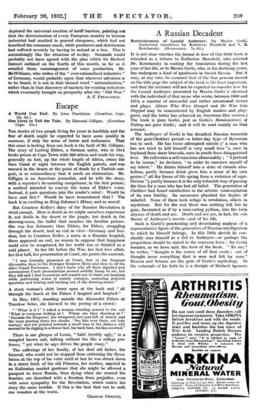Escape
One Lives to Tell the Tale. By Edmund Gilligan. (Jonathan Cape. 15s.) THE stories of two people living for years in hardship and the fear of death might be expected to have some quality in common, if only the sense of terror and endurance. That this sense is lacking from one book is the fault of Mr. Gilligan. The story of Ludwig Ehlers, a German sailor, who in 1914 broke prison at Cape Town with 800 others and made his way, generally on foot, up the whole length of Africa, swam the Suez Canal at night between the English patrols, and was rescued in the desert at the point of death by a Turkish out- post, is so extraordinary that it needs no elaboration. Mr. Gilligan is an American journalist, and he tells the story, with a reporter's devastating competence, in the first person ; a method intended to convey the tones of Ehler's voice. Instead, it puts questions into the reader's mind : Would he have said this ? Would he have remembered that ? The book is as exciting as King Solomon's Mines, and as unreal.
But Countess Keller's diary of the Russian Revolution is vivid enough. Here is death as we might ourselves experience it, not death in the desert or the jungle, but death in the drawing-room, the bullet that smashes the familiar picture. She was less fortunate than Ehlers, for Ehlers, struggling through the desert, had an end in view—Germany and free- dom, but to Countess Keller, a nurse in a Russian hospital, there appeared no end, no reason to suppose that happiness could ever be recaptured, for her world was as finished as a cold planet. In her life before the War, her first love affair, her first ball, her presentation at Court, she points the contrast.
" I was formally presented at Court, first to the Empress Alexandra, then to the Dowager Empress Marie and then to all the older Grand Duchesses. I don't know why all those dignified and ceremonious Court presentations seemed awfully funny to me, but they did and I had to exercise self-control not to burst out laughing while performing series of stately curtseys, answering gracious questions and bowing and backing out of the drawing-rooms."
A stout woman's skirt burst open at the back and " all through the lunch at the Palace I laughed and laughed."
In May, 1917, standing outside the Alexander Palace at Tzarskoe Seloe, she listened to the jeering of a crowd :
" ' What is it t' I asked a woman standing nearest to the cab 'What is everyone looking at ? Whom are they shouting at ' ' (brawls the Emperor,' she whispered, her eyes full of misery and the tears pouring down her cheeks. • See him over there, our holy martyr,' and she pointed towards a small man in the distance who seemed to be digging in a flower-bed, his back bent, his face averted."
There is one glimpse of Lenin, " bald, terribly ugly," in a rumpled brown suit, talking without fire like a college pro- fessor, " yet what he says drives the people crazy."
The sufferings of her family, of her deaf old father, the General, who could not be stopped from criticizing the Revo- lution at the top of his voice until at last he was struck down in a street broil, of the old Princess, her mother, married to an Esthonian market gardener that she might be allowed a passport to leave Russia, then dying when she crossed the frontier, are described with a freedom from prejudice, even with some sympathy for the Revolution, which makes her story the more terrible. If this is the best that can be said, one wonders at the worst.
Gamiest GREENE.






































 Previous page
Previous page